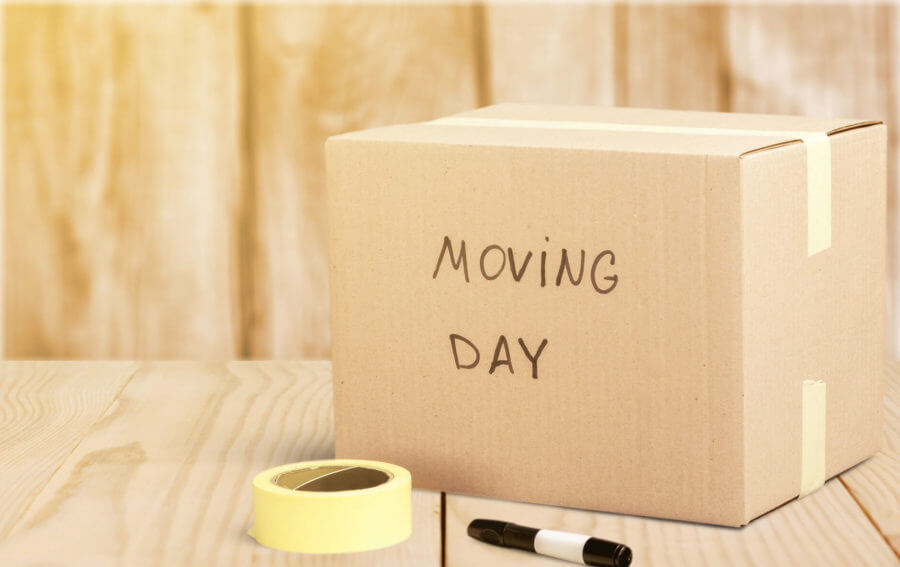

5 Helpful Tips on How to Organize Packing to Move
Posted in How-to,Moving Tips & Tricks on November 17, 2021
Sometimes people get taken aback by how much there is to do when relocating. To avoid feeling overwhelmed and losing track of time and tasks, it’s best to learn how to organize packing to move. You can accomplish a successful relocation that won’t feel like a chore with just five simple tips.
Learn How to Organize Packing to Move In Just a Few Steps
You’ll find dozens of tips and tricks on how to organize your move, but there’s no need to stack up on solutions without having the time to use them. Having just a few easy ways to pack and relocate to a new state is enough to get organized.
The most important thing about moving across the country is to create a system that would help you keep track of everything before, during, and after the move. That way, you’ll be able to see the benefits of relocating and not feel as stressed. It’s normal to be nervous, but don’t burden yourself with more than you can handle. That’s the point of organizing, anyway.
When Should I Start Packing to Move?
Another trick to avoid stress and anxiety about relocating is planning. It’d be best to start packaging around two to three weeks before moving day. That’s enough to acquire packaging supplies, decide what to bring and not to bring, and be sure no health risks are standing in the way in the case of relocating during coronavirus.

#1 Start by Creating a Moving Checklist to Pack Your Home Easier
How do you pack and move in an organized way? The best answer to that question is – make a packing and moving checklist. Creating a household inventory list to help you get an overview of items to package is the pro tip any mover and amateur alike would recommend. The biggest trouble with packaging is giving priority to some things and saying goodbye to others; an inventory list will take you down the right path and give you a chance to declutter. When you hire long-distance moving services, the cost will depend on the inventory list, so you’ll also save up wherever necessary.
Creating a separate to-do checklist is one more thing on top of the relocation essentials list. Having every step of the process written down as a task will assist you in staying organized and learning how to pack for a move fast and without a hitch.
The Difference Between a Moving Checklist and Binder
A relocation binder is a folder where you can put all your relocation-related checklists, documents, and essentials. A checklist is a bulleted or numbered list of things to do and items to bring. So the biggest difference between a binder and a list is that the list is the main thing to lean on, while a binder can simply keep all your stuff organized.
When you create checklists for every part of your move, find a binder and arrange them according to schedule or calendar. If the first thing you have to do is cancel utilities, put the contact information of each utility provider in the binder first.
Ask Long-Distance Movers What They Won’t Move to Be Prepared
While you’re learning how to organize a packing list, remember to call long-distance movers and ask about their packaging services. If you didn’t know, there’s a list of forbidden items they won’t move, hazardous for the rest of the packed belongings, and generally flammable and explosive.
Relocation companies will warn you about the dangers of transporting hazardous materials and provide a complete list of items they don’t move for safety and security purposes. That way, you can also create a do-not-package list and follow it closely.

#2 Designate a Packaging Time During the Day and Follow the Schedule
The hardest part about any difficult task is starting it. Are you also wondering, “how do I start packing to move?” If you’re in a hurry or just feel unmotivated, one of our main relocation hacks is to designate a specific time during the day when you’d package stuff. Showing up every day at the same hour will become a routine, and after a few days, you’ll be used to it.
It’s not among the most revolutionary packaging tips, but it’s a game-changer, for sure. Giving yourself a schedule will force you to focus on tasks one by one. It may not feel like you’re doing a lot at this period, but it will get the job done.
Declutter and Lower the Costs of Cross-Country Moving Services
You can significantly reduce the cost of movers and the time you spend on move-out cleaning by clearing out the things you don’t want to bring to the new home. Decluttering is a life-saver when you have to move in a hurry and lower relocation costs, and the best answer to the question of “how do you pack to move efficiently?”
There’s no need to package shoes you haven’t worn in years, so why not give them away or recycle them? There are conscious ways to get rid of stuff that no longer has space in your life, so you won’t feel bad about getting rid of it later. Look up donation and recycling centers nearby and check what condition your stuff should be in for them to take it.
The woman in the video below gives a few helpful ideas on how to declutter your space instantly. It may be useful when you start packaging to keep track of the things you wanted to throw out a while ago.
#3 Find, Buy or Borrow Boxes and Other Packaging Supplies
Another way to save for your relocation budget is to use old boxes and packaging materials. You can collect them while decluttering and set them aside for packaging. Sort out the good from the bad boxes, and make sure they’re not in an irreparable state. It’s good to reuse them, but only if they can handle the weight of their cargo.
Of course, not every box will qualify as fit for carrying cargo. Avoid oversized and very small boxes; medium work best. Other packaging essentials are:
- Packaging paper and bubble wrap – you can buy them online in bulk or find newspapers, plastic wrap, cotton cloths, and old t-shirts as free/cheap replacements. Relocation workers bring new packaging paper and bubble wrap when you hire their services,
- Besides cardboard boxes, you can use plastic containers, baskets, and even trash bags for clothes on hangers,
- Lots of duct tape – when you find a box that’s not in the best shape but seems like you could package some books in it, use the duct tape to seal the bottom. Just cover the entire surface inside and out, and make sure it holds. This is why you may need a lot of duct tape,
- Box cutters and/or scissors – it’s good to have both because standard scissors may not always be the best choice for cutting cardboard. The box cutter can be used to create holes on the sides of the boxes, to grab and carry them easier,
- Markers, pens, or stickers for labeling – whatever you have, ensure you visibly label the containers’ contents. Relocation experts will know how to arrange the containers in the relocation truck and storage units if you need them.
The Peril of Not Labeling Boxes by Room When You Pack
We feel so strongly about labeling containers when packaging that we dedicated a couple of paragraphs to it. When relocation workers pick up containers, they always treat the cargo with care and attention; however, accidents happen to the most skilled people, too.
Additionally, if you worked all day on packaging fragile items and haven’t labeled the box as ‘fragile,’ they won’t know where to place it in the truck. If it ends up in the wrong place in storage, you can expect a puzzle instead of whole dishes and glasses.
Failing to label containers can make unpacking last longer, too. When you decide to unpack, it will be very annoying to see kitchen plates at the new place where you want to organize important documents. It’s best to think about the future when you do something today, and it seems like, when it comes to relocation, labeling is one of the essentials.

#4 Pack Room by Room and from Small to Large Items
It’s not wise to package clothes at the same moment as packaging pots and pans – unless there’s a team of people doing it. If you can enlist the help of friends, family, neighbors, and whoever else is available, then it may work out. However, if you’re using all the storage alone, it’s best to package room by room.
Why is this a good idea? Starting at storage rooms like a garage or shed will help you declutter faster and find supplies. Additionally, it’ll be a way to develop some creative storage ideas when you have to sort the ‘bring’ pile from the ‘throw out’ pile.
Make One Room Your Designated Container-Storing Area
Later on, work your way around the living room and start with the furniture. Wrap the couch and chairs with some plastic or blankets. After that, take out all the clutter, decorations, and electronics. When you’re done with the small stuff, go to the big ones by dismantling the coffee table and TV stand if necessary and securing storage spaces from opening during transport.
Relocation workers pack a relocation truck by putting the largest furniture to the back and piling smaller and containers with fragile stuff on top. When you package breakable stuff and small clutter, put those containers somewhere visible or gather them together in the most accessible area.

#5 Plan What to Do With Pets and Kids When Cross-Country Movers Come to the House
Sometimes we forget the circumstances in which we move. While it doesn’t seem easy, the best option for relocating efficiently is moving alone. However, if you aren’t solo and have to plan to relocate with pets, or even more challenging, to relocate with a newborn, it would be best to find someone to take care of the kiddos.
The essentials for moving cross-country don’t usually entail maneuvering children or dogs. Some people do not have the luxury of getting paid help, but saving money means asking the ones you love for some assistance. Your parents or friends will probably be delighted to be involved in your move.
Plan this out before relocation day, so your home can be ready for the final steps. When you finally get everything out of the house and into the relocation truck, you can pick up the smallest members of your family and head out to new adventures together.

You Don’t Need a Lot to Get Organized and Pack Efficiently
Stress-free relocation is possible with a little bit of organization and patience. Next to these five tips, you can look for more ways to optimize your move and packaging process, but they’re enough to help you get started and become efficient. As long as you plan everything out and start early enough, your move is going to be one of the easiest things you’ve ever done.





